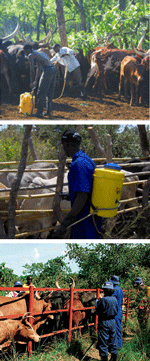STAMP OUT SLEEPING SICKNESS
|
|
Introduction to the stamp out sleeping sickness project
Background to sleeping sickness in Uganda
The spread of sleeping sickness in Uganda
Communication of research to communities and policy makers
|
New initiative - Stamp out Sleeping Sickness in UgandaThe University of Edinburgh, working in partnership with the University of Makerere, with support from the business world, namely CEVA Santé Animal and IK Investment Partners, is launching an emergency intervention to counter the recent and explosive spread of Sleeping Sickness in Uganda. Two major problems have emerged for those districts of Uganda affected by the disease: i) there is no experience of the disease either for diagnosis or treatment in newly affected areas (even in areas endemic for Sleeping Sickness it is estimated for every person able to receive treatment 12 people die undiagnosed); ii) acute Sleeping Sickness is spreading northwards towards the classical chronic T.b.gambiense Sleeping Sickness focus in West Nile and S Sudan; today the Sleeping Sickness foci are now less than 150km apart. When the two diseases meet, the diagnosis and treatment of Sleeping Sickness (which is already difficult) will be severely compromised as the methods of diagnosis and treatment differ for this fatal disease. Additionally this region has already suffered from the effects of major political instability for several decades and does not have the infrastructure to cope with emergency medical crises. Aims of the InitiativeThe primary objective of this initiative is to prevent the convergence of T. b. rhodesiense and T. b. gambiense Sleeping Sickness foci, by firstly treating >86 % of cattle in the three districts to remove infection and thereafter using a cheap treatment (at less than two US cents per month per animal) by farmers to prevent re-infection – so called restricted application of insecticide - spraying only the front legs and belly of cattle (the areas where the tsetse flies feed) with insecticide on a monthly basis. This treatment is to be given to all cattle in the newly affected districts at no cost to the local farmer for three months, thanks to the assistance of the commercial partners backing this initiative. In addition to the spraying programme, a central plank of this initiative is effective communication with the key stakeholders. The anticipated health outcome are to:
This initiative represents the first phase of a planned broader intervention to block treat cattle throughout Uganda, thus sweeping the acute form of the disease southwards, and finally eliminating it from Uganda. Should this approach prove to be as affective as expected, it can be used to help eliminate the disease from the other countries where this disease is endemic. Further information:
This website holds no responsibility for the information that external links may contain.
|
 |